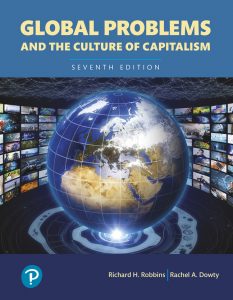Introduction
In 2011 I took a sociology class on global social problems. Three texts were required and one of them, Global Problems and the Culture of Capitalism by Richard Robbins, stood out in several ways. The book was very rich in information with many on-the-ground narratives. It had a simple but effective overarching theory; it addressed the issue of money creation, something I was already familiar with through Stephen Zarlenga and the American Monetary Institute. And it offered many interesting references I wanted, and did, pursue.
Of all the textbooks on economics, political science, history and sociology, this one counts for me as one of the best and most impactful ones during my crawl through college. And I am certainly not alone in assessing the book’s value. Though originally written in 1999 it went through seven editions, the latest in 2018, and has been translated into Polish, Korean, Chinese and Arab.
Tim Di Muzio
Now, many years later I dug into the work by the Canadian academic Tim Di Muzio and especially liked his book Debt as Power in which the destructive impact of the our debt-money capitalist regime is systemically addressed. There was a co-author involved. Last week we hosted Di Muzio on our Monetary Coffee House meeting and he shared that his foray into debt-money had more or less started with reading a book on global problems and that he had contacted its author.
A few hours later, while composing an e-mail about the sources mentioned in our meeting, did it dawn on my thick skull that the book Di Muzio referred to was Global Problems, the very same I had studied, and that its author Richard Robbins was also his co-author of Debt as Power! This put the book in a new light and I pulled out my old, underlined and annotated copy of Global Problems to give some passages another read.
Money
One of the foundational sections in the book is titled “A Primer on Money: The Philosopher’s Stone”. On Amazon you can read it as part of the “Look inside” feature on pages 4 to 11. Around page 100 (depending on the edition) one can read the basic idea reiterated:
We generally assume that governments create money by printing it. And, in fact, when money was linked to gold, there was a limit on how much could be printed. However, with the lifting of these restrictions, most money is now created by banks and other lending institutions through debt. We generally assume, also, that the money that banks lend is money that others have deposited.
However, that is not the case; only a fraction of the money that banks lend needs to be in deposits. In effect, whenever a bank lends money, or whenever a product or service is purchased on credit, money has been created. In effect, then, there is virtually no limit on the amount of money that lending institutions can create; furthermore, the interest on the loan payments creates yet more money. Economists call this debt money (Rowbotham 1998:5), or credit money (Guttmann 1994).
Though some parts of this quote could be calibrated for accuracy, the basic theory is there. Most of what we use as money is debt-money created by banks when they extend loans.
Forced Money Growth
The main thrust of the textbook is to provide empirical flesh to the following, skeletal mechanism. When banks create loans and charge interest, they do not create the money to pay off the interest. This pushes the system into finding ways to grow the money supply by making ever more loans extended to consumers and businesses. And they need to find ever more ingenious ways to create or find things and services to be sold.
In other words, the money supply must grow if the economy is to remain healthy, and for the money supply to grow there must be a steady increase in the things or services that money can buy (4th edition, p. 11).
To keep the system going, Robbins argues,
. . . there must be a constant conversion of things that have no money value into things that do–that is, there must be constant commodification.
And the maintenance and global spread of this impetus is not without problems. On the contrary, Robbins argues that many if not most global problems can be traced back to the blind and iron logic of perpetual growth and commodification. But that is not something necessarily acknowledged by its beneficiaries living in the privileged zones at the core of the world-system.
Robbins challenges this blind spot and actually in the third part of the book addresses the resistance and rebellion against the culture of capitalism by workers, feminists, ecologists, minorities, indigenous people and other citizen-activists engaging in “antisystemic protest”.
Solutions
As far as solutions to this impetus is concerned Robbins discusses a wide spectrum of possibilities. And the ones relevant to monetary reform are the reassessment of perpetual economic growth as an index of a nation’s well-being and look for alternative indices and goals. And, more explicitly, Robbins sees “Zero Economic Growth” as a valid prospect and agrees with David Korten’s proposal to:
Make the creation of national currencies a public function, rather than allowing banks and other financial institutions to increase the money supply through debt (405).
This is also what the Alliance for Just Money proposes in its promotion of the NEED Act, which boils down to the following three basic and interconnected fundamental changes:
1. Require Congress to exercise its Constitutional power to be the sole creator of all U.S. money, issued debt-free, and to establish a transparent and independent public monetary authority to determine the amount of new money the Treasury will disperse under authority of Congress.
2. End the privilege of commercial banks to create and issue what we use as money.
3. Transfer ownership of the 12 Federal Reserve Banks, and all remaining operations of the Federal Reserve System, to the U.S. Treasury.
In closing I like to reiterate that Robbins’ Global Problems and the Culture of Capitalism is a great starting point to study the connection between debt-money and global problems. Also that the books co-authored with Di Muzio will only deepen the understanding of this connective tissue and add to the motivation towards, and see the possibilities of, structural reform.
Stay tuned for more from Richard Robbins and Tim Di Muzio.
Sources
Robbins, Richard & Rachel Dowty. 2018 (1999). Global Problems and the Culture of Capitalism (Seventh Edition). New York: Pearson/Allyn & Bacon.
Di Muzio, Tim & Robbins, Richard. 2016a. Debt as Power: Theory for a Global Age. Manchester, UK: Manchester U.P.
Di Muzio, Tim & Robbins, Richard. 2017. An Anthropology of Money: A Critical Introduction. London: Routledge.
Guttmann, Robert. 1994. How Credit-Money Shapes the Economy: The United States in a Global System. London: M. E. Sharpe.
Rowbotham, Michael. 1998. The Grip of Death: A Study of Modern Money, Debt Slavery and Destructive Economics. Charlbury, Oxfordshire: Jon Carpenter.

